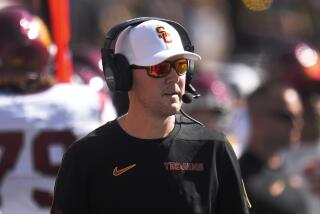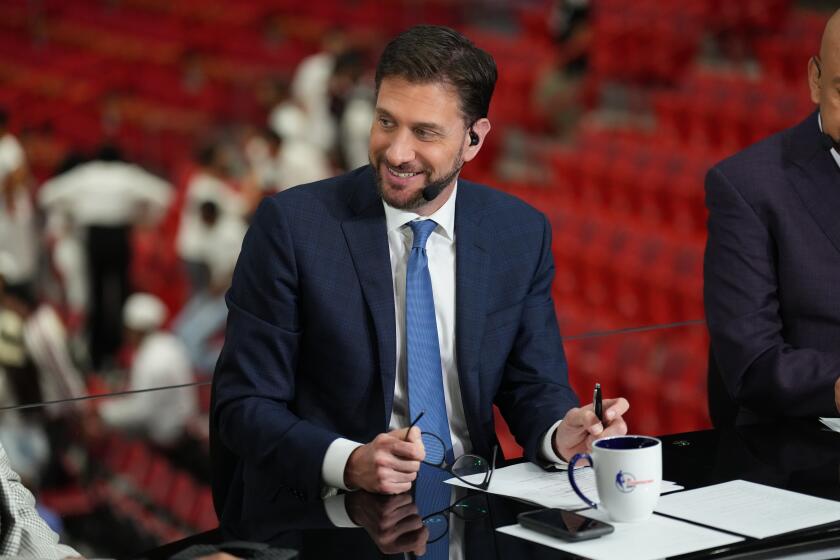She’s Just Bowling ‘Em Over : Garden Grove Amateur Kathy Butler Finally Gets Her Shot at United States Team Trials
Bowling did not come naturally to Kathy Butler. The skills that have established her as one of the country’s leading amateurs have come from innumerable hours of work.
She also has had a little help from her friends.
Butler, graduate of Santiago High School in Garden Grove, is competing in a field of 26 in the eighth biennial United States Team Trials, which begin today in Milwaukee. The top six men and women finishers will represent the U.S. in the International Bowling Federation American Zone Championships, Sept. 18-29 in Bogota, Colombia.
It is the first time she has earned that opportunity, culminating 10 years of effort. But it wouldn’t have been possible, she said, without some help from her family.
She began bowling when she was 15, learning the sport at frequent family outings to the lanes. Now in her fourth year as a competing amateur, she still relies on her family for emotional and financial support.
Butler, 25, lives with her mother and step-father in Garden Grove. She says she is particularly indebted to her mother, Peggy, who helps with the biggest dilemma an amateur bowler incurs--paying expenses.
“I have to save a lot all year,” Butler said. “It really puts a damper on my checking account. My mom helps me a lot. Without her, there’d be no way I could make it.”
Butler also owes much of her success to her best friend, Anne Marie Pike, who is ranked among the top 20 pros. As teen-agers, Butler and Pike competed in junior competition together, and have been doubles partners at the nationals for the past two years.
Competing in 24 tournaments this past season, Butler had her best year ever. She finished 20th in the Women’s International Bowling Congress’ all-events standings, which includes professionals. She credits Pike with helping her sharpen aspects of her game this year.
“I help her line up, and might make a suggestion here and there,” Pike said. “I don’t coach her, though. I might tell her to relax if there’s a lot of pressure and she’s getting upset.”
Most of Butler’s coaching since becoming a competing amateur has come from another pro friend of hers, Brian LaMagna.
“He has especially helped me develop a mental game--how to relax in tough situations,” Butler said.
The mental game is LaMagna’s specialty. In the past eight years, he has developed a method of improving concentration. He has recently finished producing a 50-minute instructional film, which he is marketing to bowlers.
“Really, the difference between good and lesser bowlers is what they concentrate on,” LaMagna said.
LaMagna admitted, however, that Butler’s steady progress would not be possible without her diligence.
“She’s a very hard worker,” he said. “Because of her size (5-feet 4-inches) and her anatomy, she’s not as fluid as some bowlers are. It hasn’t come real natural for her. She has had to put a lot of hard work into it to be able to endure.”
Despite working full-time as a salesperson, Butler still finds time to bowl three to five times a week, rolling five games a day. In order to play in as many tournaments as possible, she uses her vacation time to compete.
The dedication has resulted in her game average of 193. Only five other women in the U.S. Trials have a higher mark.
Her high scores, however, are less impressive--a 268 game and 730 series. Throughout her career, though, Butler’s strength has not been making an occasional high score, but rather her consistency.
The only tournament she has won-including her play as a junior--was a 1984 Ladies Amateur Bowlers Tour event at Seal Beach. But her ability to regularly finish among the top five in the tournaments she competes has enabled her to be one of the circuit’s top 10 amateurs.
“I’m not what you’d call a consistently high scorer,” she said. “That’s because I’m more consistent on my spares than I am at stringing lots of strikes together. I’m about 90% on my spares.”
She realizes, however, that she will have to become more adept at delivering strikes if she is to achieve what every amateur player aspires to--becoming a pro. She believes that if she continues to progress, within the next two years she can transpire that hope into reality.
“I’ve seen some of them (pros) out there and I think I can do that,” she said. “I think in maybe a year-and-a-half to two years, I can go pro.”
Said LaMagna: “Up until now, she has lacked experience. If she had that experience, she might already be a pro. She does have the capability to go pro, based on the competition that’s out there right now.”
More to Read
Go beyond the scoreboard
Get the latest on L.A.'s teams in the daily Sports Report newsletter.
You may occasionally receive promotional content from the Los Angeles Times.










